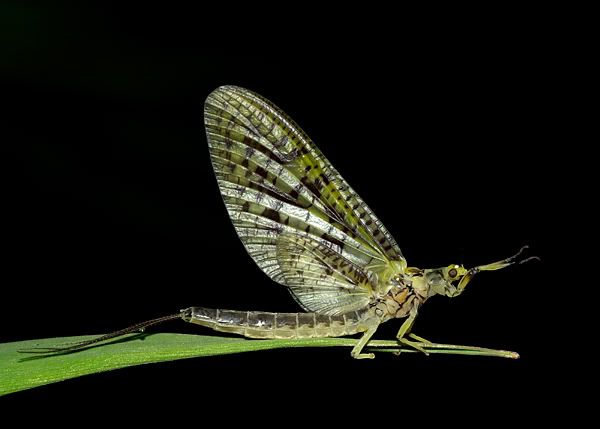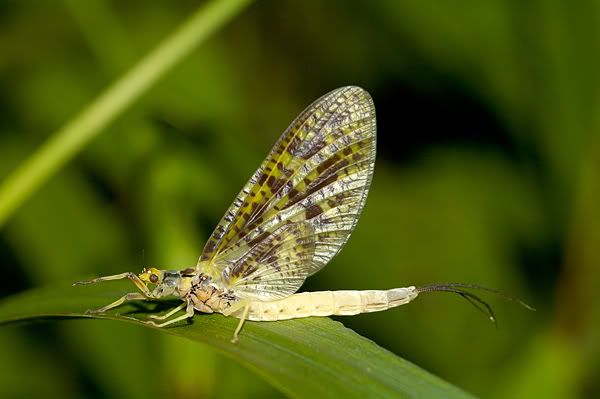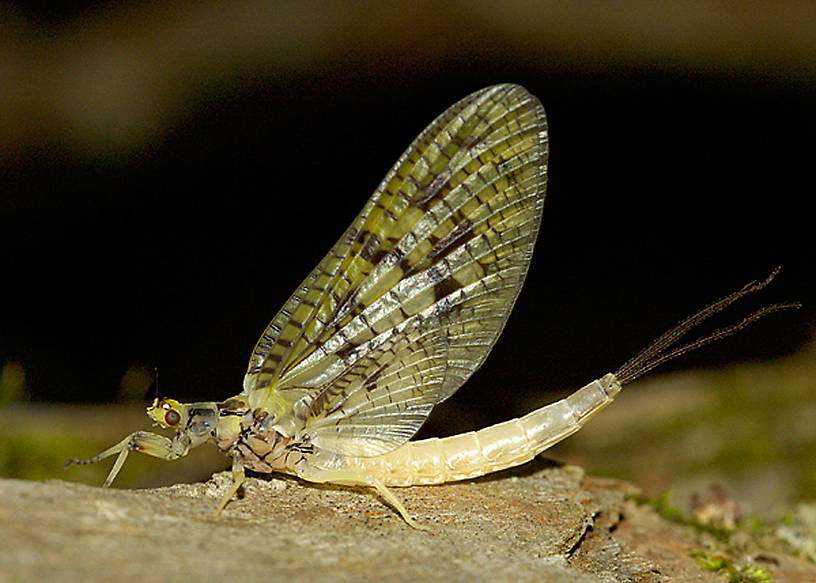Blog & Latest Updates
Fly Fishing Articles
Insects by Common Name


> > Eastern Green Drake Variations?
| NickP | June 1st, 2009, 7:41 pm | |
| WNY Posts: 10 | this is my first post and forgive me for bursting in and asking questions right away. i have zero real entomology skills just like to figure these things out purely for fishing purposes. on a small stream i fish there seem to be two distinct color variations of green drakes. one with the typical darker backed abdomen and another that is the same light cream top and bottom. i would much appreciate any info you real bugs can give on this. both bugs were taken on consecutive nights in the same stretch (within 100 yrds). this is the second time i have been able to capture both colors, the first time was the same night on the same pool and both came out of the water right in front of me so i don't think one was older than another. i have a bunch of photos of each so if something else helps please ask. any clue? thanks in advance. | |
| Taxon | June 1st, 2009, 11:43 pm | |
Site Editor Royse City, TXPosts: 1350 | Hi Nick, welcome aboard. Those are absolutely beautiful photos. It appears to me that both are Eastern Green Drake (Ephemera guttulata) female duns, and simply reflect a variation in tergite coloration. Unfortunately, I am unable to offer any explanation for why that might be, as you reported witnessing their emergence from the same pool on successive evenings, and that would seem to eliminate both aging and water chemistry as possibilities. However, there are others on this forum who may be able to offer you a better answer. | |
| Best regards, Roger Rohrbeck www.FlyfishingEntomology.com | ||
| Wbranch | June 2nd, 2009, 12:24 pm | |
| York & Starlight PA Posts: 2733 | ||
| Catskill fly fisher for fifty-five years. | ||
| Konchu | June 3rd, 2009, 3:24 am | |
Site Editor IndianaPosts: 505 | The wing markings are different between the two. Maybe different spp.? | |
| NickP | June 3rd, 2009, 4:46 am | |
| WNY Posts: 10 | well thanks for the opinions so far. i have been searching around and i can't seem to find any pics of the all cream variety from any other streams except another close to the one i am fishing. i am beginning to wonder if the lighter one i am most familiar with is a variation only found in my area. the vast majority of the ones i have seen are the lighter version in WNY and very few of the darker ones. | |
| Taxon | June 3rd, 2009, 6:22 am | |
Site Editor Royse City, TXPosts: 1350 | Hi Konchu-The wing markings are different between the two. Maybe different spp.? Perhaps, although the taxonomic history of Ephemera guttulata seems to be completely absent any evidence of worker opinion differences. Another possibility is that the photo of the second mayfly is actually an Ephemera guttulata female imago (spinner), which was suggested by Wbranch (Matt). When wings are as heavily stained as these, the hyaline appearance tends to disappear, and that makes it a bit tricky differentiating between those of a dun and those of a spinner, particularly from photos. | |
| Best regards, Roger Rohrbeck www.FlyfishingEntomology.com | ||
| NickP | June 3rd, 2009, 7:22 am | |
| WNY Posts: 10 | Roger, i'm positive these are duns as opposed to spinners. here are a few more pics if this works. if not i'll get them up tonight. i don't know what's up with posting pics on this site but nothing works unless uploaded here and it won't let me do that in a reply so here's a link to a bunch of pics of the cream ones. there is even a pic of the cream spinner for comparison. http://oakorchardflies.proboards.com/index.cgi?board=insects&action=display&thread=1817 | |
| Konchu | June 3rd, 2009, 1:42 pm | |
Site Editor IndianaPosts: 505 | maybe one is teneral and we can see the eggs thru the abdomen; the variation in wing maculation bugs me a little, tho. I am used to seeing the dramatic white abd. But these are all reasons that ID of female duns is daunting and apt to leave one "dun shucked." | |
| Martinlf | June 3rd, 2009, 2:06 pm | |
Moderator Palmyra PAPosts: 3233 | Cool pics and great questions, Nick. I'll bet we get some answers in a bit. How about the undersides of these two, were they significantly different in color? I'm thinking about what the trout sees the most of. | |
| "He spread them a yard and a half. 'And every one that got away is this big.'" --Fred Chappell | ||
| Konchu | June 4th, 2009, 9:43 am | |
Site Editor IndianaPosts: 505 | E. varia and E. simulans are the other two Ephemera known from New York. http://mypage.iu.edu/~lmjacobu/NewYork.htm | |
| GONZO | June 4th, 2009, 12:59 pm | |
Site Editor "Bear Swamp," PAPosts: 1681 | Nick, The additional photos on your website explain the color variations in your guttulata duns very well. They are caused by the darkening of the duns after emergence. Your other photos show the duns in various stages of darkening. You can see how the dark dorsal coloration develops and the dark maculation of the wings increases as the dun "ages." These are beautiful and fascinating shots. Could you make the website address an active link so that others can just click it to see these changes? | |
| NickP | June 4th, 2009, 1:31 pm | |
| WNY Posts: 10 | Gonzo- thanks for the help here and the last thing i want to do is disqualify your response. in these two pics of the two color phases i was standing in a pool when the first insect, appeared to me anyway, to fly directly from the water, i snagged it with my hat and took this pic. i got back into the pool to resume casting and then this insect did the same thing, was captured and photo'd. you can even see it's the same bank grass they were set upon.  same pool within ten minutes of each other both seemed to be as fresh as possible. this was a couple of seasons ago and i then did the same thing a few night ago with the insects in the original photos i posted. this leads me to believe there was not much if any difference in the "age" of each insect. i can't seem to make that link active either so if anyone wants to see it they are going to have to copy and paste, my apologies. another question is has anyone else ever seen any of the all cream varieties? i have searched through hundreds of photos of green drakes online and can't find another one of that all cream color phase. in fact the first time i saw one from another watershed i didn't think it was a green drake until further research. the mystery continues! | |
| GONZO | June 4th, 2009, 1:43 pm | |
Site Editor "Bear Swamp," PAPosts: 1681 | I really don't think it is a mystery, Nick. Although considerable variation in coloring is common with many species, one thing I notice about most of the paler duns is that they have shorter, limp-looking tails. This is a sign of a freshly emerged dun. The other duns with intermediate degrees of dorsal and hindwing darkening show the stages between your top and bottom photos. (The next-to-last dun photo on your website shows a male dun in the intermediate stage of darkening quite well.) You can make the link active by adding url inside square brackets before the web address and /url inside square brackets after the address. | |
| NickP | June 4th, 2009, 2:16 pm | |
| WNY Posts: 10 | i understand what you are saying about the age but by having each insect captured within seconds of it's emergence from the water makes me skeptical that it is age related. http://oakorchardflies.proboards.com/index.cgi?board=insects&action=display&thread=1817 | |
| GONZO | June 4th, 2009, 2:27 pm | |
Site Editor "Bear Swamp," PAPosts: 1681 | OK, although duns can be on the water (especially near the edge) for various reasons and long after they have emerged, you can easily resolve this question: Provided that the emergence isn't over, capture one of the pale-bodied duns and hold it in a container for a few hours (just to be safe, the darkening can be fairly quick). If it has not darkened dorsally in that time, you have an unusual population that seems to have two distinct color phases. I'm eager to know what you find out. PS--I just noticed that you had the last dun labeled as a yellow drake, so I deleted that comment. | |
| NickP | June 4th, 2009, 3:08 pm | |
| WNY Posts: 10 | well that's a great idea Gonzo. i should be able to get that done in a day or two and hopefully (and for more reasons than that!) they are still going. thank you for your help on this little puzzle that has been bothering me for the past few seasons. | |
| Konchu | June 4th, 2009, 3:10 pm | |
Site Editor IndianaPosts: 505 | You could always send a off a couple of fresh specimens of each, if you can get them, for DNA work. PM me if you are interested. | |
| GONZO | June 4th, 2009, 3:35 pm | |
Site Editor "Bear Swamp," PAPosts: 1681 | Nick, Just to follow up, let me explain two scenarios that might have a bearing on your photos. The first involves the possibility of two color phases within a population, and the second explains how you could easily see two duns of different degrees of age-related darkness come off the water around the same time: Having different color phases (dark and light) within a species is certainly not unheard of. If the mayflies currently classified as Maccaffertium vicarium are indeed a single species (and I'm not really questioning that), encountering light and dark duns of that species is a routine thing. These are the famous March Browns and Gray Foxes that we all know and love. Other species (including other Maccaffertium) are reported to have dark and light phases, although they may have different times of emergence (earlier and later). It seems a bit unusual to have these phases emerging at the same time, and I have not heard of that with Green Drakes before. However, I'm not denying that it is possible. The other scenario involves weather conditions at the time of emergence. Although duns that emerge at this time of year often fly almost immediately off the water and into the trees, that is not always the case. Just last year around this time, I intercepted a notable emergence of one of my favorite mayflies, Drunella cornuta, on the Brodheads. The cornuta duns show a dramatic color change from bright pale green (nearly chartreuse) to a dull dark olive within a fairly short period of time after emergence. The emergence on that particular morning came in waves, but the first wave of duns just sat by the hundreds on the rocks and water along the edge. They collected there for more than an hour without taking flight. I assume this was due to cool air temperatures, although humidity may also have been a factor. Later in the emergence, the sun broke through and warmed the air considerably. A second wave emerged, and the air filled with duns that were flying off the water. Some were the darker duns that had emerged earlier, and some were the lighter duns that were currently emerging. Although I don't want to discount the possibility of different color phases, the short, limp tails of the paler duns in conjunction with the photo of a male dun that appears to be in an intermediate stage of darkening make me think that you might be seeing something similar--older duns and freshly emerged duns taking to the air at the same time. PS--Please take Konchu up on his offer if you can (especially if that dun doesn't darken). | |
| NickP | June 4th, 2009, 4:56 pm | |
| WNY Posts: 10 | Konchu- i appreciate the offer greatly and i will do my best to capture a specimen of each. i will also ask a few friends who fish the creek to help out. if i can get them i will PM you for the details. Gonzo- thank you for the follow up, it all does make sense. a few years ago i did keep a specimen of the light one and kept it till it turned into a spinner where it was, of course, all light. i did however take photos of them the next day when it was still a dun. this was years ago and the photos likely suck but i'll bet i can find them and they were digital, i will look tonight. hopefully we can get to the bottom of this one way or another. thank you all for your help. | |
| GONZO | June 4th, 2009, 5:03 pm | |
Site Editor "Bear Swamp," PAPosts: 1681 | I'd certainly be interested in seeing the other photo you mentioned, Nick, but I hope you can get those duns as well. If Konchu finds something unusual in their DNA, that would be the most intriguing outcome of all! Best, Lloyd | |
Quick Reply
You have to be logged in to post on the forum. It's this easy:
Related Discussions
| Title | Replies | Last Reply |
| Re: Need help.. In Fly Tying by Nightangler | 1 | Sep 16, 2006 by GONZO |
| Re: Bingo for the hebe page! In Female Leucrocuta hebe Mayfly Spinner by GONZO | 6 | Nov 12, 2006 by Martinlf |
| Re: Callibaetis Spinner Habits In the Mayfly Species Callibaetis ferrugineus by WildcatRob | 8 | Jan 7, 2009 by Dgracia |
| Re: Help with ID In the Identify This! Board by Calloway | 2 | Jul 9, 2008 by Wiflyfisher |
| A general understanding of BWO patterns In Fly Tying by AndyV | 0 | |
| Re: White Mayfly ---- Euphron leukon? In the Identify This! Board by JumpNotZero | 1 | Sep 9, 2008 by GONZO |
| Re: Ventral view In Male Ephemerella excrucians Mayfly Dun by Martinlf | 1 | Sep 6, 2020 by Troutnut |
| Re: Help identifying? In the Identify This! Board by Doublezz105 | 3 | Jul 9, 2007 by Taxon |
| Re: Small BWO In General Discussion by Lastchance | 2 | Aug 30, 2010 by Lastchance |
| Re: Old Orvis line with alternating black and cream colors?? In Gear Talk by Craveman1 | 1 | Feb 26, 2020 by Martinlf |
Troutnut.com is copyright © 2004-2024 Jason
Neuswanger (email Jason). See my FAQ for information about use of my images.
 privacy policy
privacy policy






